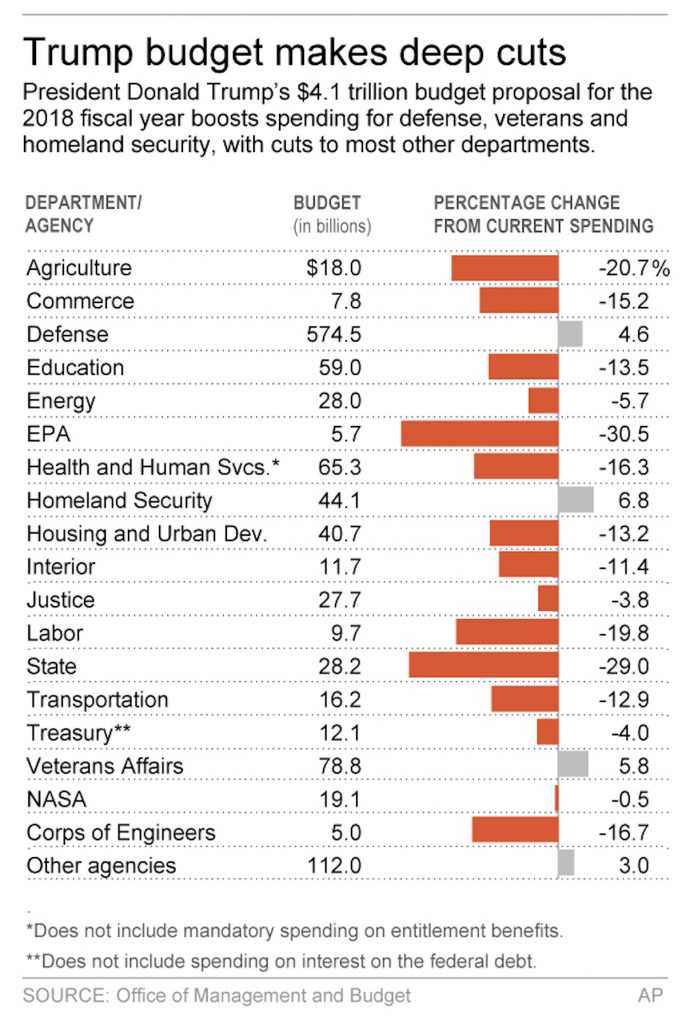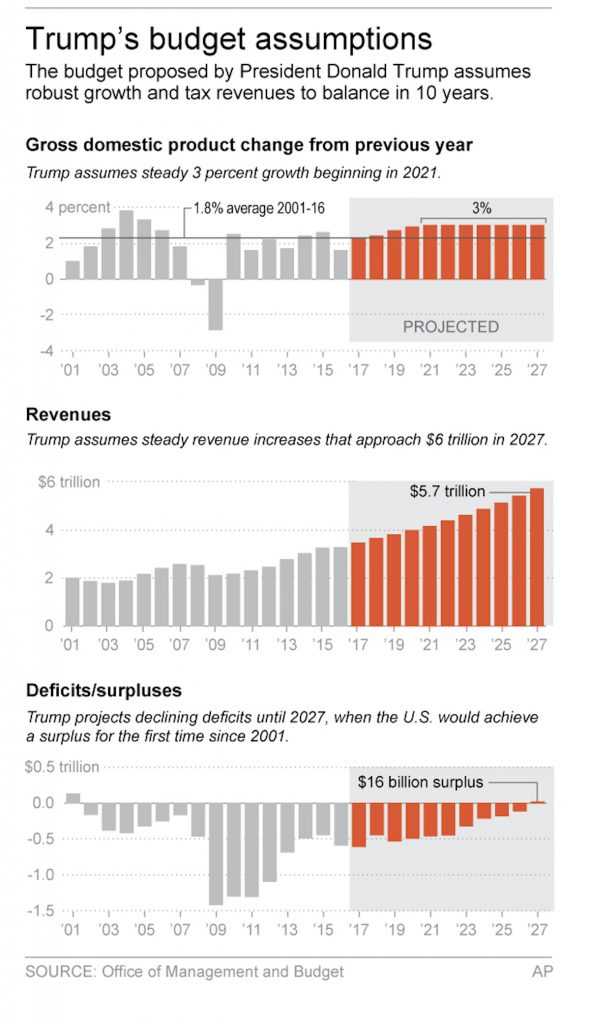WASHINGTON – President Donald Trump fulfilled a major campaign promise Tuesday, proposing a $4.1 trillion budget plan that would upend Washington in a big way. But he drew rebukes, even from some Republican allies, for the plan’s jarring, politically unrealistic cuts to the social safety net for the poor and a broad swath of other domestic programs.
The budget, Trump’s first as president, combines his spending plan for the upcoming 2018 fiscal year with a promise to balance government books after a decade, relying on aggressive cuts, a surge in economic growth — and a $2 trillion-plus accounting gimmick.
“Through streamlined government, we will drive an economic boom that raises incomes and expands job opportunities for all Americans,” Trump declared in his budget message.

“Basically dead on arrival,” opined the Senate’s No. 2 Republican, John Cornyn of Texas.
The proposal reflects a conservative vision of smaller government, a drastic rollback of programs for the poor and disabled to prod them into the workforce and a robust hike for the military and border security. It foresees scuttling Barack Obama’s health care law and an overhaul of the tax code, a boon to the wealthiest U.S. citizens.
The plan is laced with $3.6 trillion in cuts to domestic agencies, food stamps, Medicaid, highway funding, crop insurance and medical research, among others. Many of the voters who propelled Trump into the presidency last November would see significantly less from the federal government.
“We’re no longer going to measure compassion by the number of programs or the number of people on those programs, but by the number of people we help get off those programs,” said Mick Mulvaney, director of the Office of Management and Budget and a former tea party congressman.
At the same time, the blueprint boosts spending for the military by tens of billions and calls for $1.6 billion for a border wall with Mexico that Trump repeatedly promised voters the U.S. neighbor would finance. Mexico emphatically rejects that notion.
The proposal got a chilly reception from congressional Republicans and Democrats, who insist they will have the final say as they struggle to complete a health care bill and rewrite the tax code.
Food stamp cuts would drive millions from the program, while a wave of Medicaid cuts — on top of more than $800 billion in the House-passed health care bill — could deny nursing home care to millions of elderly poor people. It would also force some people on Social Security’s disability program back into the workforce.
“These cuts that are being proposed are draconian,” said veteran GOP Rep. Harold Rogers, who represents a poor district in eastern Kentucky. “They’re not mere shavings, they’re deep, deep cuts.”
Said Sen. Bill Cassidy, Republican from Louisiana: “I don’t think the president’s budget is going anywhere.”
The budget would reduce pension benefits for federal workers by $63 billion by eliminating cost-of-living adjustments for most and by requiring employees to make larger contributions. In agriculture, it would limit subsidies to farmers, including for purchasing crop insurance, an idea already attacked by farm state lawmakers.
“We’ve lost 40 percent of our wheat crop and you’re telling me there’s going to be large cuts to crop insurance?” asked Senate Agriculture Committee Chairman Pat Roberts, Republican from Kansas. “Come on. That doesn’t add up.”
The Trump plan would roll back Obama-era increases to a children’s health program for lower-income families who don’t qualify for Medicaid, take an ax to the Environmental Protection Agency (EPA) and climate change programs, cut $95 billion from highway trust fund transfers to state highway departments, and curb payments to disabled veterans of retirement age who are eligible for Social Security.
Trump’s budget holds true to his campaign pledge to leave Medicare and Social Security pension benefits alone and contains spending increases for the military and veterans, but it treats most of the rest of the government as fair game. Student loan subsidies, home heating assistance and Great Lakes cleanup would be on the chopping block as the departments of education, environment, energy and State take hits.
“In the America of President Trump’s budget, children, working families, seniors and people with disabilities will be ‘fined,’ while the wealthiest Americans will get a ‘bonus.’ What’s so ‘great’ about that America?” asked Sen. Dick Durbin of Illinois.

The budget does feature a handful of domestic initiatives, including a six-week paid parental leave program championed by Trump’s daughter Ivanka that would be designed and financed by the states through cuts to unemployment insurance. Some $200 billion in federal infrastructure investments are promised to leverage another $800 billion in private investment, though the idea has yet to get much traction.
During the campaign, Trump attacked the weak economic growth of the Barack Obama years, and pledged that his economic program would boost growth from the lackluster 2 percent rates seen since recovery began in mid-2009. Trump’s new budget assumes sustained growth above 3 percent, sharply higher than the expectations of most private economists. Without more than $2 trillion in such “economic feedback” over the coming decade, the nation’s budget would never reach balance and would run a deficit of almost $500 billion.
Trump’s balanced-budget goal depends not only on the growth projections but also a variety of accounting gimmicks, including an almost $600 billion peace dividend from winding down overseas military operations and “double counting” $2.1 trillion in revenue from economic growth — using it to both pay for tax cuts and bring down the deficit.
The proposal projects that this year’s federal deficit will rise to $603 billion, up from $585 billion last year. It projects that if Trump’s initiatives are adopted the deficit will start declining and actually disappear by 2027.










